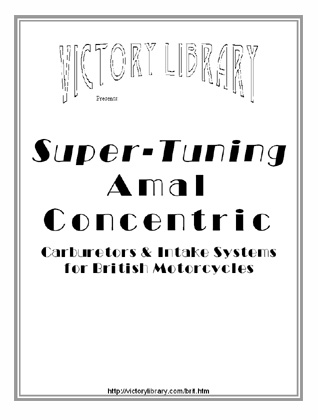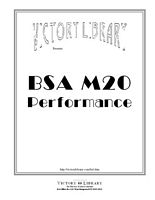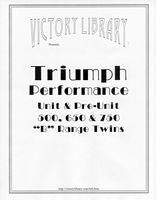|
|
 |
Multiple Carburetor Intake Manifold Linkage
Straight vs. progressive
Progressive linkage retains the best starting, idle, & part throttle characteristics, and good enough fuel distribution at mid-range for good mileage.
Straight linkage = more carburator area open = less vacuum = more gas. Not what you want. Straight linkage will need richer jetting than progressive for good response at every throttle position except full (where they will match), idle quality will be worse - even though mixture distribution looks better, the reduced vacuum signal ruins it. |
Linkage geometry
The proportion of carburetor lever arm lengths (measured from the throttle shaft to the linkage hole on the arm) determines how far the primaries open before the secondaries begin, but all must reach WOT at the same point. Typically, the progression varies from the primaries 1/3 open to 2/3 open before the secondaries crack - and that means that the secondary arms must be only 1/3 to 2/3 × the length of the primary arm(s) to do this. If the secondaries open at 1/3 throttle, the arm length ratio must be 3:1 (the primary arm is 3 × the secondary arm, measured from the throttle shaft to the linkage arm hole), etc. Shown here is a Barry Grant carburetor set. |
 |
|
Click the picture for a larger view in a separate window.
The primary link can go to either secondary carburetor - whichever is easier, but it should pull rather than push in operation. The “slack” (how far the connecting link can move freely before the secondary arm moves) is the same deal - there must be 2/3 slack before contact is made, then the remaining 1/3 movement opens the secondaries.
Linkage between the 2 secondaries is direct and 1:1, links to the same place on both arms, and doesn’t touch the primary carburetor.
The return spring should be at 90° to the primary arm at idle, and I suggest a second spring at 90° to the WOT position (but be careful that one does not pull the other over-center). Frequently, a third return spring is added to only the secondary linkage, both for safety, but also to tell you by “foot feel” when they open. If they seem to open when you’re just loafing, add more slack and faster ratio. If they don’t open until almost WOT, use less slack and slower ratio.
All arms should be as long as possible for best accuracy in adjustment, and should be roughly vertical (at 90° to the throttle cable or rod to the pedal) at mid-range.
The link between the primary and secondary slides freely until it reaches an adjustable stop. Adjust the individual arms first to the desired ratio: 1/3 - 2/3 means the secondary arm is 2/3 the length of the primary, etc. If you want 1/3 - 2/3, the block is at 1/3 of the link length, etc.
Test, using 1/3 as ratio of choice:
1. Open the throttle slightly from idle stop.
2. The primary should move immediately, but the link connecting it to the secondaries slides
freely without moving the secondary arms.
3. Move the throttle to 1/3 open.
4. The sliding stop on the connecting link now contacts the secondaries.
5. Opening the primary beyond this point opens all three carburators, with the secondaries moving
much faster. If the manifold is off the car, a strong light underneath each secondary will show
exactly when they open.
6. All 3 carburators reach full throttle just as the linkage bottoms out.
7. Release the throttle, and all linkage returns to normal.
There are only 3 things that can go wrong:
1. The linkage doesn’t return, goes over center, etc. - very bad, you get killed.
2. The secondaries do not reach full open together - some cylinders run lean.
3. One side (primary or secondary) doesn’t open all the way - harmless except for a
minor power loss. |
A ratio of 1/3 primary carburetor(s) to 2/3 both carburetors may not be enough for a small engine and heavy car to cruise without using the secondaries, using 1/2 - 1/2 allows higher engine RPM on primaries only for better mileage. You must have enough range on the primary to do whatever cruising speed the car is capable of.
4 or 8 carburetors
All 2 × 4 360° manifolds (divided single plane), both original factory and aftermarket, use the rear carburetor as the primary and choke. The fact that these two barrels, used for starting, idling and traffic, aren’t centered in the manifold doesn’t seem to hurt, all are like that including the original hemi.
If they were solidly connected, all that would happen is that all 4 would open together, and stop when the secondaries reach full throttle.
Based on that, my preference for a 4 carburetor in-line manifold (4 total, or 4 on each bank) would be to use #3 (counting from the front) as the sole primary, then #2, then # 1 & 4, but the linkage will be a bit complicated.
Next choice is #1 & 3 for low speed, and #2 & 4 for secondaries.
As to simultaneous (“straight”) linkage: which engine it is isn’t relevant, and they’re all going to be at full throttle together regardless of what linkage is used.
The arms from both primaries must be exactly the same length (between throttle shaft and heim joint), and operate at the same angle, the secondaries the same (although obviously different length and angle).
However, manifolds with known distribution problems may require alternate settings, as well as any reports of poor mileage, large difference in plug color, knocking on only a few cylinders, &c. |
See these Victory Library booklets |

| 
| 
| 
| 
| 
| 
| 
| 
|

| 
|

|

|

|
GMC, supercharger, blower, 6-71, 671, 8-71, 871, pressure, adapt, convert, manifold
|



